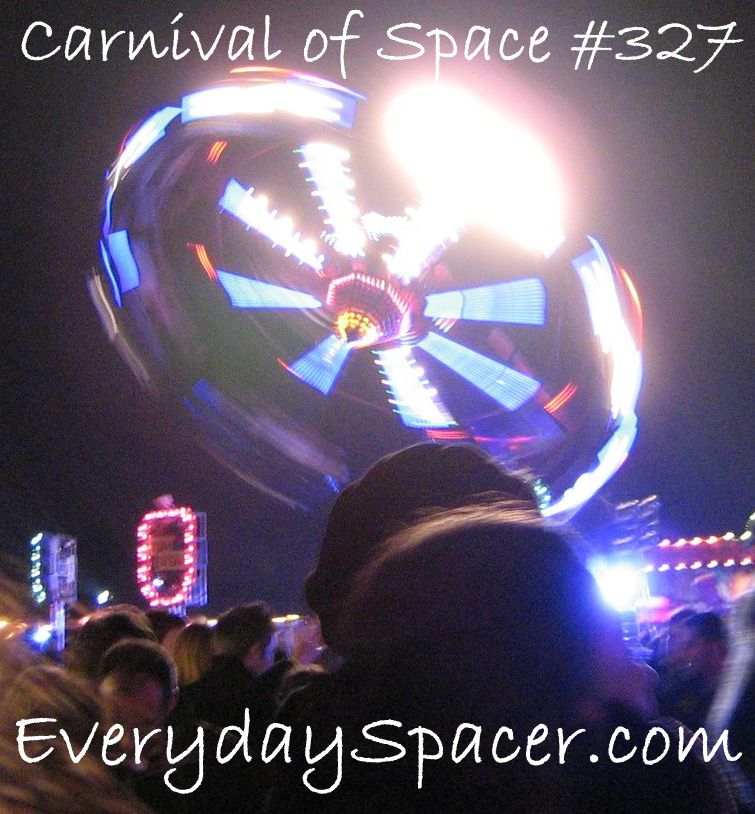 Welcome to Carnival of Space #327!
Welcome to Carnival of Space #327!
Every week, a different blogger hosts a variety of articles submitted by other ‘carnival’ members to bring you a symphony of voices in the spacer blogosphere.
EverydaySpacer.com is the host this week.
If you’d like to know more, stop by the Carnival of Space Page.
Big news this week about Earth like planets in the “Goldilocks Zone” around other stars and the eclipse.
On with the show!
Partial Solar Eclipse
Gadi Eidelheit | The Venus Transit
An eclipse is a truly global event. Here is my summary of last week solar eclipse from Israel.
Getting a Sense of Place in Our Universe
Megan Watzke | Chandra X-Ray Observatory
Thinking about the sheer vastness and the enormous scale of the Universe that we can explore using modern telescopes…
Different Flavor of Eclipse
Here. There. Everywhere.
One of the most ubiquitous phenomena in the Universe is light being blocked. – See more at: http://hte.si.edu/blog/different-flavor-of-eclipse/#more-269
Billions of Potentially Earth-Like Planets in our Galaxy
Paul Scott Anderson | The Meridiani Journal
“With around 200 billion stars in our galaxy, and about 20% or 40 billion of those being sun-like stars, that means at least 8.8 billion such planets, according to the new research. Some estimates put that number even higher. Wow. Previous studies have also suggested such high numbers, and now the latest Kepler data continues to back that up.”
Early Supermassive Black Holes First Formed as Twins
Jason Major | Universe Today
How did supermassive black holes get so… well, supermassive… in the early Universe, when seemingly not enough time had yet passed for them to accumulate their mass through steady accretion processes alone?
Not all failure is failure
Steve Shurtleff | Photos to Space
Every mishap leads to improvement. Steve Shurtleff of Photos To Space takes a look at the latest test of the Dream Chaser and what can be learned from the flight.
Asteroid Size Danger Chart
Brian Wang | Next Big Future
Megatonage of energy from impacts of asteroids of different sizes
Discovery of Three Large, Near-Earth Asteroids From 1 mile to 12 miles in Diameter and Research Indicates Small Asteroid Strikes are Ten Times More Common Than Previously Thought
Brian Wang | Next Big Future
Three large, near-Earth asteroids, two of which measure about 12 miles in diameter — are the largest near earth asteroids to have been discovered in 23 years. The smallest of the three asteroids measures little more than a mile across, but it may pass within 3.4 million miles of Earth, making it a “potentially hazardous asteroid.”
When an asteroid exploded over the Russian city of Chelyabinsk in February, shattering windows for miles and injuring well over 1,000 people, experts said it was a rare event — of a magnitude that might occur only once every…
Tens of Billions of Earth Sized Planets in the Habitable Zone
Brian Wang | Next Big Future
Based on a statistical analysis of all the Kepler observations, astronomers at UC Berkeley and University of Hawaii, Manoa now estimate that one in five stars like the sun have planets about the size of Earth and a surface temperature conducive to life.
Given that about 20 percent of stars are sun-like, the researchers say, that amounts to several tens of billions of potentially habitable, Earth-size planets in the Milky Way Galaxy.
Solar-Electric Ion Engines Designed with Simple to Advanced Molecular Nanotechnology Requirements
Brian Wang | Next Big Future
Tom McKendree is now working at Raytheon and has an updated analysis of solar electric ion engines using different levels of molecular nanotechnology (none, simple, complex and advanced)
Watch for updates until Carnival of Space #328 is Live!
Original image source: http://www.flickr.com/photos/conskeptical/291812845/






































Pingback: Space-for-All at HobbySpace » Carnival of Space #327 – Everyday Spacer
Pingback: Carnivalia — 11/06 – 11/12 | Sorting out Science
Pingback: Carnival of Space #327 | Dear Astronomer | Bringing space back down to earth!